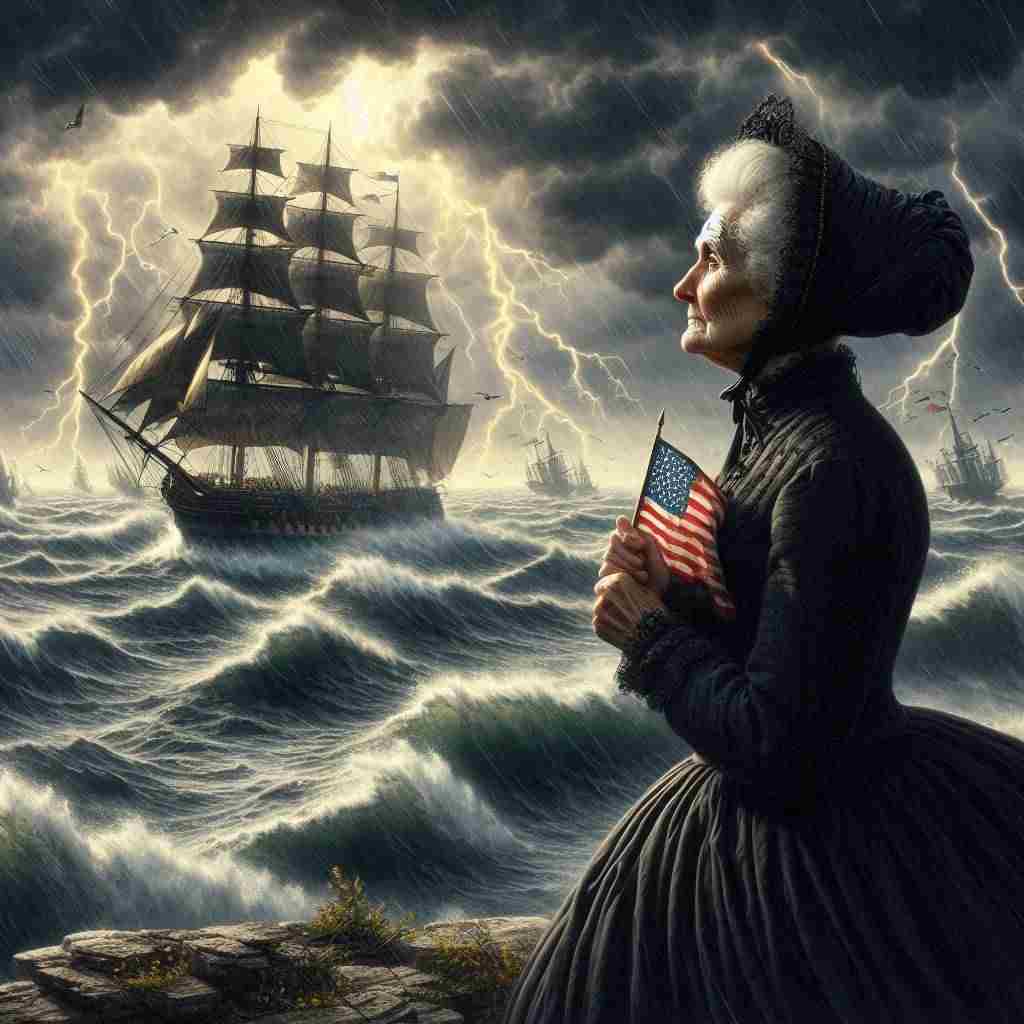Old Ironsides
Oliver Wendell Holmes, Sr.
1809 to 1894

Want to track your favorites? Reopen or create a unique username. No personal details are required!
Ay, tear her tattered ensign down!
Long has it waved on high,
And many an eye has danced to see
That banner in the sky;
Beneath it rung the battle shout,
And burst the cannon’s roar;—
The meteor of the ocean air
Shall sweep the clouds no more!
Her deck, once red with heroes’ blood
Where knelt the vanquished foe,
When winds were hurrying o’er the flood
And waves were white below,
No more shall feel the victor’s tread,
Or know the conquered knee;—
The harpies of the shore shall pluck
The eagle of the sea!
O, better that her shattered hulk
Should sink beneath the wave;
Her thunders shook the mighty deep,
And there should be her grave;
Nail to the mast her holy flag,
Set every thread-bare sail,
And give her to the god of storms,—
The lightning and the gale!
Oliver Wendell Holmes, Sr.'s Old Ironsides
Introduction
Oliver Wendell Holmes, Sr.'s "Old Ironsides" stands as a testament to the power of poetry in shaping public opinion and preserving national heritage. Written in 1830, this impassioned plea for the preservation of the USS Constitution not only succeeded in its immediate goal but also cemented itself as a quintessential piece of early American literature. Through a masterful blend of patriotic fervor, maritime imagery, and subtle critique of societal values, Holmes crafted a work that transcends its historical context to speak to the universal themes of honor, legacy, and the passage of time.
Historical Context and Immediate Impact
To fully appreciate the nuances of "Old Ironsides," one must first understand its historical backdrop. The USS Constitution, nicknamed "Old Ironsides" for its seemingly impenetrable oak hull, had played a crucial role in the War of 1812, becoming a symbol of American naval prowess and national pride. However, by 1830, the ship had fallen into disrepair, and the U.S. Navy considered scrapping it. Holmes, then a young law student, penned this poem in response to the news, publishing it in the Boston Daily Advertiser.
The poem's impact was immediate and profound. Its stirring verses ignited public sentiment, leading to a grassroots campaign that ultimately saved the Constitution from destruction. This real-world effect underscores the poem's rhetorical power and highlights the potential of literature to effect tangible change in society.
Structural and Stylistic Analysis
"Old Ironsides" consists of three octaves, each following an ABCBDEFE rhyme scheme. This structure, reminiscent of the ballad form, lends the poem a musical quality that enhances its emotional appeal. The regular meter, primarily iambic tetrameter interspersed with trimeter lines, creates a rhythmic ebb and flow that mirrors the ocean's waves—a fitting choice for a poem about a naval vessel.
Holmes employs a rich tapestry of literary devices throughout the work. The opening line, "Ay, tear her tattered ensign down!" is a masterclass in alliteration, immediately capturing the reader's attention with its harsh consonants. This exclamation, framed as an imperative, serves a dual purpose: it echoes the presumed order to dismantle the ship while simultaneously challenging the reader to consider the implications of such an act.
The personification of the Constitution as a female entity—"her tattered ensign," "Her deck," "her shattered hulk"—is a common nautical tradition, but it also imbues the ship with a sense of vulnerability and nobility. This personification is juxtaposed against the masculine imagery of battle and conquest, creating a complex interplay of gender dynamics that reflects the multifaceted nature of national identity.
Imagery and Symbolism
Holmes's use of imagery is particularly evocative, painting a vivid picture of the Constitution's glory days and its current state of decay. The "tattered ensign" and "thread-bare sail" serve as poignant symbols of the ship's decline, while also hinting at the wear and tear of the young nation's ideals. The contrast between the ship's past—when "many an eye has danced to see / That banner in the sky"—and its present state creates a sense of nostalgia and loss that permeates the poem.
The metaphor of the Constitution as a "meteor of the ocean air" is particularly striking. This celestial imagery elevates the ship beyond its physical form, transforming it into a symbol of inspiration and awe. The subsequent line, "Shall sweep the clouds no more," carries a note of finality and regret, emphasizing the tragedy of losing such a magnificent entity.
Perhaps the most powerful image comes in the final stanza, where Holmes suggests that it would be better for the ship to "sink beneath the wave" than suffer the indignity of being dismantled. This preference for a noble end over a degrading survival speaks to deeper cultural values regarding honor and legacy. The vivid description of the ship's "thunders" shaking "the mighty deep" serves as a reminder of its former power and the respect it commands.
Thematic Exploration
At its core, "Old Ironsides" is an exploration of the tension between progress and preservation, a theme that resonates well beyond its immediate context. The poem raises questions about the value of historical artifacts in a rapidly changing world. Holmes seems to argue that there is intrinsic worth in maintaining connections to our past, even (or perhaps especially) when they no longer serve a practical purpose.
The poem also grapples with the concept of dignity in decline. The preference for a dramatic, natural end—giving the ship to "the god of storms, / The lightning and the gale"—over a slow dismantling by "The harpies of the shore" reflects a romantic worldview that values heroic endings over pragmatic solutions. This perspective challenges readers to consider how we treat our national symbols and, by extension, our veterans and elders.
Furthermore, "Old Ironsides" subtly critiques the notion of progress at any cost. The potential destruction of the Constitution can be seen as a metaphor for the erosion of foundational values in the face of modernization. Holmes's impassioned defense of the ship is, in a broader sense, a call to preserve the ideals and sacrifices upon which the nation was built.
Literary and Cultural Legacy
The enduring popularity of "Old Ironsides" speaks to its literary merit and cultural resonance. Its inclusion in countless anthologies and its continued study in American literature courses attest to its status as a classic of 19th-century poetry. The poem's success also established Holmes as a significant literary figure, paving the way for his later works and his role in the formation of American literary identity.
Moreover, "Old Ironsides" has become a touchstone for discussions about the power of poetry to influence public opinion and policy. It serves as a prime example of literature's potential to bridge the gap between artistic expression and civic engagement, a theme that would become increasingly important in the socially conscious literature of the late 19th and early 20th centuries.
Conclusion
Oliver Wendell Holmes, Sr.'s "Old Ironsides" is far more than a simple plea for the preservation of a ship. It is a nuanced exploration of national identity, the value of history, and the power of symbols in shaping cultural narratives. Through its masterful use of poetic devices, evocative imagery, and emotional resonance, the poem transcends its specific historical moment to speak to universal human concerns about legacy, honor, and the passage of time.
As we continue to grapple with questions of preservation versus progress in our own era, "Old Ironsides" remains remarkably relevant. It challenges us to consider the tangible and intangible heritage we choose to maintain and the manner in which we do so. In its lines, we find not only a celebration of a specific naval vessel but also a timeless reflection on the values we hold dear and the lengths to which we will go to protect them. Holmes's poetic intervention saved a ship, but more importantly, it preserved a piece of the American spirit, ensuring that the ideals embodied by the Constitution would continue to inspire generations to come.
This text was generated by AI and is for reference only. Learn more
Want to join the discussion? Reopen or create a unique username to comment. No personal details required!



Comments
No comments yet. Be the first to comment!